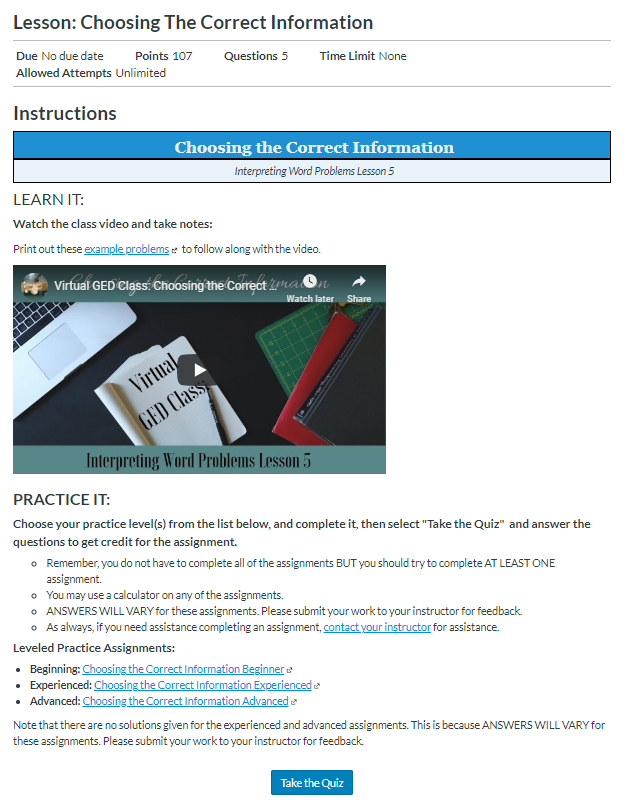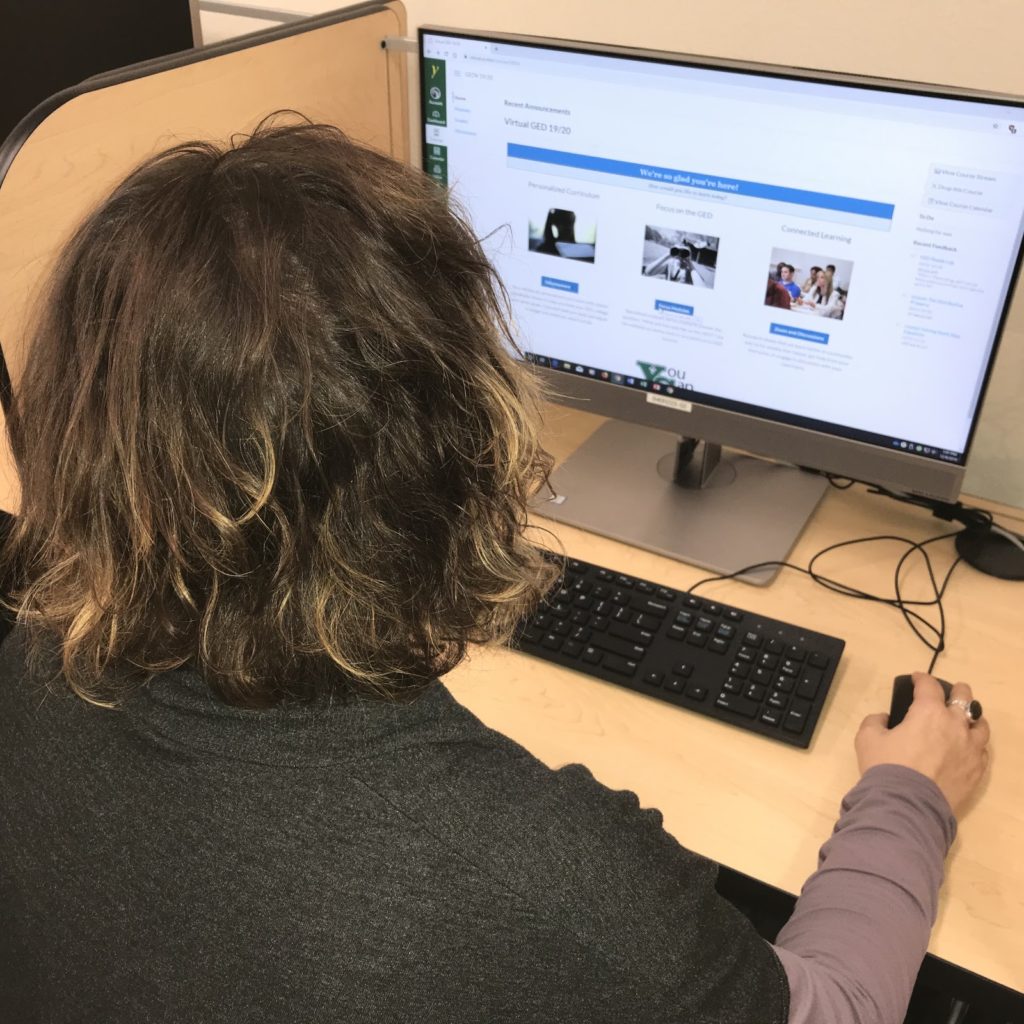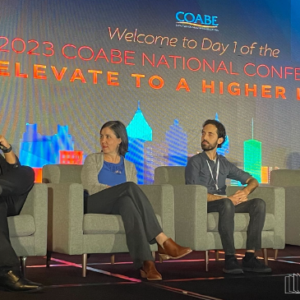by Kate Redmon, Instructional Specialist and Curriculum Developer at Yavapai College ABE/ASE
Let me tell you, I’m all about free and open educational resources.
For years I was a private contractor, tutoring adults with disabilities through Vocational Rehabilitation, a U.S. Department of Education funded program that provides individualized rehabilitation program, counseling and guidance, training, job placement, and services to support job retention to people whose disability may make it challenging to work. I tutored on dozens of subjects from diesel mechanics to cosmetology to medical billing to GED prep. I was given learners from all walks of life, in all types of career fields, with all kinds of disabilities, but the one thing I wasn’t given – learning materials! So, I turned to the internet with its wealth of free and low cost resources.
Open Education Resources = More Online Teaching and Learning Options
Sites like Khan Academy allowed me to choose and assign lessons to students based on their needs. Quizlet provided a free adaptable study platform where I could produce and gather study materials into subjects. YouTube put the world’s best teachers a search away and provided a platform to extend my own reach as an educator. Math Antics and Kuta and Desmos and Pinterest– oh my! What a smorgasbord of learning options! I could Google anything a student needed to learn and shift through thousands of options. And sift I did! As any educator can tell you, not all free resources are created equal. Over the years, I developed a tried and true stockpile of proven online tools.
I brought those tools with me when I transitioned to teaching in an adult basic education program in 2015. Upon being hired, I immediately began compiling a “Virtual GED Textbook” in Canvas, our program’s learning management system, with links to thousands of free, high quality learning resources. My students used the “textbook” inside and outside of class to review, to differentiate, and speed up their progress.
But there was a problem: they weren’t getting credit for it as time spent in distance learning. Canvas had no reliable means to track time on task so, unless they were in class, the hundreds of hours my students spent studying with the textbook went unrecorded. This wasn’t such a big deal for my in-person classes, after all, they had plenty of class hours to record, but for my Distance Learners, who often opted to work entirely on Canvas assignments, it was devastating to my program’s federal reporting tables. The students who used my Canvas resources were getting their GED’s, but many of them didn’t reach the minimum of 12 hours to qualify them for reporting. I’d have students work literally hundreds of unrecorded hours. The Distance Learners who did qualify were those using the purchased pre-packaged curriculum and they often didn’t make gains or get their GED’s before they gave up.
New Arizona State Policy = Increased Support for Use of OER
In early 2019 the State of Arizona’s Department of Adult Education adopted a new policy which was a game changer for my work. It approved use of and provided guidance for use of the Teacher Verification Method (TVM). The TVM model has opened doors to let teachers in Arizona assign a set number of curriculum hours to assignments they create or assign. As soon as I heard the good news, I immediately set to work adding structure to my Canvas course so that learner time spent there could be counted. Essentially, I organized my materials into units I coined “Focus Modules”, which are thematically organized series of activities. As students complete the activities, they are granted proxy minutes in the form of “points”.
 What’s in a Focus Module?
What’s in a Focus Module?
My goal in the design of Focus Modules was to provide a range of options. If there’s anything I learned working with adults with disabilities, it’s that there is no such thing as “one size fits all” for learning! A culmination of years of resource creation and gathering, the modules include web based videos, practice assignments, reviews, and quizzes that I’ve made, adapted and found over the years.
Students choose the appropriate Focus Module based upon their goals and previously discussed needs. Within each module, I’ve included a mix of quizzes, lessons, and reviews.
Within each lesson, students have even more options. Each lesson includes at least one video lesson and leveled practice options. Students are instructed to watch the video lesson and complete at least one of the levels of practice. Which practice level they complete is entirely up to them. I have students using this leveled practice in a myriad of ways. Some students always do all three activities in turn, building their depth of knowledge topic by topic. Others work through an entire unit at the beginner level, then go back and try the experienced practice in each lesson, then cycle back through at the advanced level. Still others jump right in at a higher level to challenge themselves. The choice is theirs.
 The videos and practices link to all over the internet: Khan and Math Antics, Kuta and Crash Course, TV411 and Quizlet, as well as my own YouTube Channel, Light & Salt Learning, are all featured. Students log their time by completing a short survey. Each quiz question asks whether or not they completed a certain part of the lesson and awards “points” based on the number of minutes I’ve assigned that piece. For example, a twenty-two minute video would be worth 22 points, and therefore 22 proxy minutes of attendance. Videos, of course, were simple to assign time for. To alot time for the various practice assignments, I observed my classroom students and looked back at the data from an older model of my Canvas Class where I asked students to self-report the time they spent working on each assignment.
The videos and practices link to all over the internet: Khan and Math Antics, Kuta and Crash Course, TV411 and Quizlet, as well as my own YouTube Channel, Light & Salt Learning, are all featured. Students log their time by completing a short survey. Each quiz question asks whether or not they completed a certain part of the lesson and awards “points” based on the number of minutes I’ve assigned that piece. For example, a twenty-two minute video would be worth 22 points, and therefore 22 proxy minutes of attendance. Videos, of course, were simple to assign time for. To alot time for the various practice assignments, I observed my classroom students and looked back at the data from an older model of my Canvas Class where I asked students to self-report the time they spent working on each assignment.
Curious to take a closer look? Watch the video tour.
And how are my students taking to the new class design? In the semester I’ve been using the focus modules, I’ve seen retention increase dramatically, attendance hours per DL student per month more than double, and an increase in the rate of post-testing. Best of all, I keep hearing those magical words from students, “Kate, I think I can actually do this.” Yes, we can.




